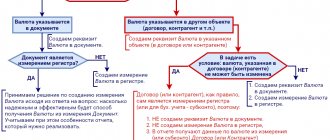Introductory information
In civil legislation there is a rule according to which the use of foreign currency, as well as payment documents in foreign currency when making payments on the territory of the Russian Federation, is permitted in cases, in the manner and under the conditions determined by law (clause 3 of Article 317 of the Civil Code of the Russian Federation). That is, the use of foreign currency is, in principle, allowed. But only in cases that are expressly provided for by law. Therefore, for different types of legal relations it is necessary to analyze different legal norms. Let's look at specific examples.
Converting salaries into foreign currency
Let us immediately draw attention to two important provisions of labor legislation: 1. Terms of remuneration (including the size of the tariff rate or official salary, additional payments, allowances and incentive payments) must be included in the employment contract (Part 1 of Article 57 of the Labor Code of the Russian Federation) ; 2. Payment of wages is made in cash in the currency of the Russian Federation, that is, in rubles (Article 131 of the Labor Code of the Russian Federation).
However, there is no prohibition on setting the payment in currency (for example, dollars or euros). It turns out that you can pay wages in rubles, for example, at the dollar exchange rate on the day of payment.
Risks
If we talk about risks, then it is worth mentioning one more requirement of the Labor Code of the Russian Federation: “the employer is obliged to provide employees with equal pay for work of equal value” (paragraph 6, part 2, article 22 of the Labor Code of the Russian Federation). It would seem, how does this relate to currency? However, imagine that one employee has a salary in euros, and another in rubles. With the same functionality at the end of the month, they should, in theory, receive the same amount. But if the exchange rate changes, it may turn out that ruble earnings will differ significantly.
By the way, official bodies also believe that setting wages not in rubles does not comply with labor legislation and infringes on the rights of workers (letter of Rostrud dated March 11, 2009 No. 1145-TZ). The rationale is this: a change in the exchange rate of the ruble against a foreign currency can lead to a deterioration in the employee’s remuneration conditions (for example, if the exchange rate depreciates and wages in rubles become less).
In this regard, setting wages in foreign currency is dangerous. It cannot be completely ruled out that the employer may be held administratively liable under Art. 5.27 of the Code of Administrative Offenses of the Russian Federation (which provides for fines or suspension of activities).
Currency informant - exchange rates of the Central Bank of the Russian Federation for today, February 5 and tomorrow (-)
At the top there is a block with the official exchange rates of the Central Bank of Russia for today and tomorrow. Data is updated daily on weekdays, on weekdays from 13 to 15 hours. The dollar exchange rate as of February 5, 2021 is calculated on the previous day based on the results of the weighted average exchange price at 11:30 and published on the website of the Central Bank of the Russian Federation. Official exchange rates are broadcast from the server of the Central Bank of the Russian Federation for the following instruments: USD - dollar rate , EUR - euro rate , UAH - hryvnia rate , BYR - Belarusian ruble rate . Please note that the Ukrainian hryvnia exchange rate is published by the Bank of Russia at the rate of 10 hryvnia, and the Belarusian ruble rate is calculated at 1000 units. You can see the full list of exchange rates of the Central Bank of Russia for today and tomorrow in the currency informant table
| Lit. code | Units | Currency | Course for 05/02 | Course for 06/02 | Change | |||
| USD | 1 | U.S. dollar | 75.73 | 75.11 | -0.62 | |||
| EUR | 1 | Euro | 90.92 | 89.89 | -1.04 | |||
| UAH | 10 | Ukrainian hryvnia | 27.13 | 27.05 | -0.08 | |||
| BYN | 1 | Belarusian ruble | 28.73 | 28.60 | -0.14 | |||
| KZT | 100 | Kazakhstan tenge | 17.95 | 17.88 | -0.08 | |||
| JPY | 100 | Japanese yen | 71.98 | 71.23 | -0.75 | |||
| AUD | 1 | Australian dollar | 57.80 | 57.22 | -0.58 | |||
| AZN | 1 | Azerbaijani manat | 44.57 | 44.21 | -0.36 | |||
| GBP | 1 | UK pound | 102.89 | 102.89 | +0.01 | |||
| AMD | 100 | Armenian drams | 14.54 | 14.43 | -0.11 | |||
| BGN | 1 | Bulgarian Lev | 46.45 | 46.00 | -0.45 | |||
| BRL | 1 | Brazilian real | 14.15 | 13.84 | -0.31 | |||
| HUF | 100 | Hungarian forints | 25.53 | 25.31 | -0.22 | |||
| DKK | 1 | Danish krone | 12.21 | 12.10 | -0.12 | |||
| INR | 10 | Indian rupees | 10.39 | 10.30 | -0.08 | |||
| CAD | 1 | Canadian dollar | 59.24 | 58.70 | -0.54 | |||
| KGS | 100 | Kyrgyz soms | 89.28 | 88.55 | -0.73 | |||
| CNY | 1 | CNY | 11.72 | 11.59 | -0.12 | |||
| MDL | 10 | Moldovan lei | 43.34 | 42.98 | -0.35 | |||
| NOK | 10 | Norwegian kroner | 87.97 | 87.15 | -0.82 | |||
| PLN | 1 | Polish zloty | 20.22 | 20.01 | -0.21 | |||
| RON | 1 | Romanian leu | 18.64 | 18.45 | -0.19 | |||
| SGD | 1 | Singapore dollar | 56.72 | 56.15 | -0.57 | |||
| TJS | 10 | Tajik somoni | 66.46 | 65.92 | -0.54 | |||
| TRY | 1 | Turkish lira | 10.59 | 10.59 | +0.01 | |||
| TMT | 1 | New Turkmen manat | 21.67 | 21.49 | -0.18 | |||
| UZS | 10000 | Uzbek soums | 71.85 | 71.81 | -0.04 | |||
| CZK | 10 | Czech crowns | 35.10 | 34.81 | -0.29 | |||
| CHF | 1 | Swiss frank | 84.00 | 83.21 | -0.80 | |||
| ZAR | 10 | South African rand | 50.61 | 50.31 | -0.30 | |||
| KRW | 1000 | Won of the Republic of Korea | 67.72 | 66.83 | -0.89 | |||
Setting currency prices in contracts
Some Russian suppliers have recently begun to offer their customers to switch to payments in foreign currency. However, as a general rule, currency transactions between residents are prohibited (Article 9 of the Federal Law of December 10, 2003 No. 173-FZ “On Currency Regulation and Currency Control”). For illegal currency transactions, Rosfinnadzor may fine the manager or chief accountant in an amount ranging from three-quarters to one of the transaction amount (Part 1, Article 15.25, Article 23.60 of the Code of Administrative Offenses of the Russian Federation).
Civil legislation provides that payments on the territory of the Russian Federation are carried out in rubles (Article 140, paragraph 1 of Article 317 of the Civil Code of the Russian Federation). At the same time, in paragraph 2 of Art. 317 of the Tax Code of the Russian Federation states that a monetary obligation can be paid in rubles in an amount equivalent to a certain amount in foreign currency or in currency. e.. In this case, the amount payable in rubles is determined at the official exchange rate of the relevant currency or y. e. on the day of payment, unless a different rate or another date for its determination is established by law or by agreement of the parties.
This means that between organizations (or entrepreneurs) the price in the contract can be set in currency or ye. In this case, the contract can agree on the rate at which the price will be converted into rubles. If there is no such agreement, then the official rate will apply. In this regard, significant fluctuations are possible in ruble terms.
How is it deciphered?
Now let's look in more detail at what it means to decipher the first 5 digits in a current account. They constitute a certain group of bank balance sheet accounts. These accounts are approved by the Bank of Russia and include two sections.
The first consists of three numbers and means the specifics of the calculations. For example, the following combinations have different meanings:
- from 102 to 109 - fund accounts, as well as capital storage, accounting for profits and losses;
- 203 and 204 - accounts for accounting for precious metals;
- from 301 to 329 - accounts for conducting transactions between banks;
- 401 and 402 - accounts for transfers to the budget;
- 403 - management of money under the jurisdiction of the Ministry of Finance;
- 404 - extra-budgetary funds;
- 405 and 406 - accounts of state companies;
- 407 - legal companies and individual entrepreneurs;
- 408 - individuals;
- from 411 to 419 - deposits opened by government agencies;
- from 420 to 422 - storage of funds of legal entities;
- 423 — deposit opened by a resident individual;
- 424 - funds of foreign companies;
- 425 - funds on deposit belong to a non-resident individual;
- 430 - bank funds;
- from 501 to 526 - accounts necessary for accounting for securities.
The next 2 digits of numbering in a bank account complement the previous 3 and are interpreted inseparably with them. Let's look at the example of legal companies (the first three digits are 407):
- 40701 - the organization is related to the financial sector (it could be a microfinance company, a pension fund, etc.);
- 40702 - this includes open and closed societies;
- 40703 - accounts of non-profit associations;
- 40704 - Funds appropriated for elections or public meetings.
Other sections of the account number
The next three digits on the invoice indicate the currency in which the account is opened. The most common among them are the combinations presented in the table.
| Three digits account | Currency |
| 810 | The account is opened in rubles |
| 840 | In US dollars |
| 978 | In Euro |
| 980 | In hryvnias |
| 344 | In Hong Kong dollars |
| 156 | In yuan |
For example, if a Sberbank account begins with the numbers 408, and numbers 7 to 9 indicate 643, then the account was opened by an individual in rubles. If the combination 407018 40 is present, then the account is opened by a financial institution in dollars.
This is followed by a verification number. It is also called a key, which will allow you to find out whether the account is designated correctly using computer processing. The Bank of Russia has developed a special method for calculating it based on the remaining numbers included in the number. For the account owner, such a figure does not carry significant significance.
The next 4 digits indicate in which branch the account was opened. If zeros are indicated instead, then it is possible that the bank does not own branches and the account was opened at the head office.
The last 7 digits of the account indicate the serial register of the account in the credit institution. Any bank has the right to apply its own classification of these figures. However, there are some limitations. For example, if a correspondent account of a credit institution is opened with the Central Bank, then the last 3 digits will be the last 3 of the BIC, and the 4 before them will be zeros.
Ruble code 810 or 643 - explanation of the central bank
Here is a document from the official website of the Central Bank of the Russian Federation:
Price tags in e. or currency
Let's assume that the seller decides to indicate prices in currency or conventional units. However, information about goods (works, services) must necessarily contain the price in rubles. This is the requirement of paragraph 4, paragraph 2, art. 10 of the Law of the Russian Federation dated 02/07/92 No. 2300-1 “On the protection of consumer rights.”
At the same time, regarding the question of indicating prices in foreign currency or currency. e. there are different approaches. On the one hand, Rospotrebnadzor (Information dated December 17, 2014) does not exclude the possibility of establishing the contract price in rubles in an amount equivalent to a certain amount in foreign currency (cu).
On the other hand, there are precedents in judicial practice when indicating prices in foreign currency or currency. e. was recognized as contrary to the requirements of the legislation on the protection of consumer rights (see, for example, resolution of the Federal Antimonopoly Service of the Ural District dated March 13, 2007 No. F09-1474/07-S1). And for this, administrative liability is possible on the basis of Article 14.8 of the Code of Administrative Offenses of the Russian Federation. In this regard, setting prices in currencies or conventional units is quite risky.
Agreement in foreign currency: tax consequences
USN and cash method
Let’s assume that an organization using the simplified tax system has entered into an agreement for the supply of goods with another organization. The contract specified the cost in dollars and payment in rubles.
When “simplified”, the date of receipt of income is the day of receipt of funds (clause 1 of Article 346.17 of the Tax Code of the Russian Federation). That is, it turns out that the price specified in the contract in dollars does not matter. The tax will need to be calculated based on the ruble amount received.
The situation is similar with income tax when applying the cash method - income is also determined on the date of receipt of funds (clause 2 of Article 273 of the Tax Code of the Russian Federation). Income is recognized in the same way under the Unified Agricultural Tax (clause 5 of Article 346.5 of the Tax Code of the Russian Federation). That is, differences in exchange rates are, in fact, not taken into account.
Exchange differences for income tax
Before 2015, amount differences could arise when calculating income tax. This happened when the foreign currency exchange rate was different on the date of recognition of income (expenses) and on the date of actual receipt of funds. Depending on the fluctuation of the exchange rate, receipts or expenses should have been reflected in non-operating income or expenses (clause 11.1, part 2, article 250, subclause 5.1, clause 1, article 265 of the Tax Code of the Russian Federation).
However, from January 1, 2015, the concept of “amount differences” is no longer used in tax accounting. Differences that arise when making payments under contracts in foreign currency or currency. That is, they must be taken into account as coursework. For more details, see “Starting 2015, tax and accounting rules will be closer to each other.”
Note that exchange rate differences arise when revaluing and depreciating obligations and claims denominated in foreign currency (if the exchange rate changes). Thus, since 2015, the value of claims (obligations) expressed in foreign currency is recalculated into rubles at the official rate established by the Bank of Russia, or at another rate determined by law or agreement of the parties, on the date of termination (fulfillment) of claims (obligations) and (or) on the last day of the current month, depending on which date came earlier (clause 8 of Article 271, clause 10 of Article 272 of the Tax Code of the Russian Federation).
VAT deductions and invoices
If the purchased goods are intended for use in transactions subject to VAT, then the buyer, if there is an invoice, has the right to accept the amount of “input” VAT for deduction after accepting the goods for registration (clause 2 of Article 171, paragraph 1 of clause 1 of Article 172 of the Tax Code RF). However, the amounts of VAT that are accepted for deduction are not adjusted if the cost of goods established in foreign currency is paid in rubles (paragraph 5, clause 1, article 172 of the Tax Code of the Russian Federation).
Positive or negative differences in the amount of VAT that arise for the buyer when paying should be taken into account as part of non-operating income or expenses on the basis of Article 250 or Article 265 of the Tax Code of the Russian Federation (paragraph 5 of clause 1 of Article 172 of the Tax Code of the Russian Federation).
Special mention should be made about the preparation of invoices. The fact is that the name of the currency is a mandatory detail of the invoice (clause 6.1, clause 5, clause 4.1, clause 5.1, article 169 of the Tax Code of the Russian Federation). The name of the currency and its digital code are indicated on line 7 of the invoice. For example, when issuing an invoice in rubles, line 7 of the invoice must be filled out as follows: “Russian ruble, 643.”
An invoice can be drawn up in a foreign currency only if the goods (work, services) are paid for in the same currency (Clause 7, Article 169 of the Tax Code of the Russian Federation). So, if the invoice is issued in euros or dollars, then in this line you should indicate: “euro, 978” or “US dollar, 840”. But issuing an invoice in . i.e., in principle, not provided for.
In this regard, if the agreement is drawn up in currency or conventional units, and payments are made in rubles, then the invoice should be issued in the currency of the Russian Federation (since the tax base is calculated in rubles, clause 4 of Article 153 of the Tax Code of the Russian Federation).
Source documents
Please note: monetary measurement of accounting objects is carried out in the currency of the Russian Federation (Part 2 of Article 12 of the Federal Law of December 6, 2011 No. 402-FZ “On Accounting”). If, for example, salaries in foreign currency are reflected in the primary documents, then problems with the recognition of labor costs when calculating income tax cannot be ruled out. To recognize such expenses, we recall that the expenses must be documented (Article 255 of the Tax Code of the Russian Federation). It is possible that inspectors will consider the primary documents filled out “in foreign currency” to be inconsistent with the legislation of the Russian Federation. This may lead to problems with the deduction of VAT.
The invoice is in euros, but the payment is in rubles: how to issue an invoice?
Question from Clerk.Ru reader Tatyana (Moscow)
Account in EURO. Payment in rubles. Should the invoice be issued in rubles?
In accordance with paragraph 7 of Art. 169 of the Tax Code of the Russian Federation, if under the terms of the transaction the obligation is expressed in foreign currency, then the amounts indicated in the invoice can be expressed in foreign currency. Thus, tax legislation provides for the possibility of indicating amounts in foreign currency on the invoice.
Please note that in paragraph 7 of Art. 169 of the Tax Code of the Russian Federation refers to the currency of the obligation, and not to the currency of payment. According to the Information Letter of the Presidium of the Supreme Arbitration Court of the Russian Federation dated November 4, 2002 No. 70, the concepts of currencies are separated: in which a monetary obligation is expressed (debt currency) and in which it must be paid (payment currency) (clause 1 of the Information Letter).
A monetary obligation may stipulate that it is payable in rubles in an amount equivalent to a certain amount in foreign currency or in conventional monetary units (clause 2 of Article 317 of the Civil Code of the Russian Federation). According to the Federal Tax Service of the Russian Federation, expressed in Letter No. 3-1-07/674 dated August 24, 2009, it is impossible to issue an invoice in foreign currency or in conventional monetary units (under an agreement for which the obligation to pay is provided in rubles in the amount , equivalent to a certain amount in foreign currency (conventional monetary unit)). Invoices can be issued in foreign currency only if, under the terms of the transaction, the obligation is payable in foreign currency.






